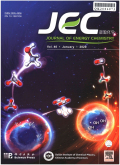- 钛学术文献服务平台 \
- 学术期刊 \
- 工业技术期刊 \
- 石油与天然气工业期刊 \
- 能源化学期刊 \
Effects of guanidinium cations on structural, optoelectronic and photovoltaic properties of perovskites
Effects of guanidinium cations on structural, optoelectronic and photovoltaic properties of perovskites
基本信息来源于合作网站,原文需代理用户跳转至来源网站获取
摘要:
Guanidinium (GA) cations are intentionally introduced in MAPbl3 perovskite by considering its potential capability of stabilizing the material through plenty of hydrogen bonds and mitigating hysteresis because of the zero dipole moment.The configurations of GA cation in film and its effects on structural,optoelectronic and photovoltaic properties of perovskite have been comprehensively studied by systematically modulating the GA ratio.It has been demonstrated that moderate GA cations can effectively passivate the defect surrounding perovskite grains,yielding an enhanced efficiency as high as ~19.2% in a p-i-n type planar solar cells with the GA ratio of 15%.Further increasing the GA ratio deteriorates device performance,as extra GA cations hinder grain growth and thus reduce the grain size,which facilitates the defect generation around the enhanced interface.Moreover,a new two-dimensional (2D) layered perovskite phase that features alternating GA and MA cations in the interlayer space (ACI) appears ultimately,while the ACI phase typically suffers from slow charge transportation across the parallel PbI2 octahedral layers separated by large A-site cations.

推荐文章
Optoelectronic Properties for Main Group Element-Bridged Ladder Compounds
Densityfunctionaltheory
Electronicproperty
Ladder-typemolecule
Maingroupelement
Photophysicalproperty
Damming effects on dissolved inorganic carbon in different kinds of reservoirs in Jialing River, Sou
River damming
Water chemistry
Reservoir types
Dissolved inorganic carbon isotope composition
DIC concentration
探索 After Effects 在动画专业制作中的应用
After Effects(AE)
动画制作
功能应用
动画效果
内容分析
关键词云
关键词热度
相关文献总数
(/次)
(/年)
引文网络
引文网络
二级参考文献 (0)
共引文献 (0)
参考文献 (0)
节点文献
引证文献 (0)
同被引文献 (0)
二级引证文献 (0)
2021(0)
- 参考文献(0)
- 二级参考文献(0)
- 引证文献(0)
- 二级引证文献(0)
引文网络交叉学科
相关学者/机构
期刊影响力
能源化学
主办单位:
中国科学院大连化学物理研究所
中国科学院成都有机化学研究所
出版周期:
双月刊
ISSN:
2095-4956
CN:
10-1287/O6
开本:
出版地:
大连市中山路457号
邮发代号:
创刊时间:
语种:
eng
出版文献量(篇)
2804
总下载数(次)
0
期刊文献
相关文献
推荐文献
- 期刊分类
- 期刊(年)
- 期刊(期)
- 期刊推荐
一般工业技术
交通运输
军事科技
冶金工业
动力工程
化学工业
原子能技术
大学学报
建筑科学
无线电电子学与电信技术
机械与仪表工业
水利工程
环境科学与安全科学
电工技术
石油与天然气工业
矿业工程
自动化技术与计算机技术
航空航天
轻工业与手工业
金属学与金属工艺
能源化学2022
能源化学2021
能源化学2020
能源化学2019
能源化学2018
能源化学2017
能源化学2016
能源化学2015
能源化学2014
能源化学2013
能源化学2012
能源化学2011
能源化学2010
能源化学2009
能源化学2008
能源化学2007
能源化学2006
能源化学2005
能源化学2004
能源化学2003
能源化学2002
能源化学2001
能源化学2021年第9期
能源化学2021年第8期
能源化学2021年第7期
能源化学2021年第6期
能源化学2021年第5期
能源化学2021年第4期
能源化学2021年第3期
能源化学2021年第2期
能源化学2021年第12期
能源化学2021年第1期

 免费查重
免费查重










